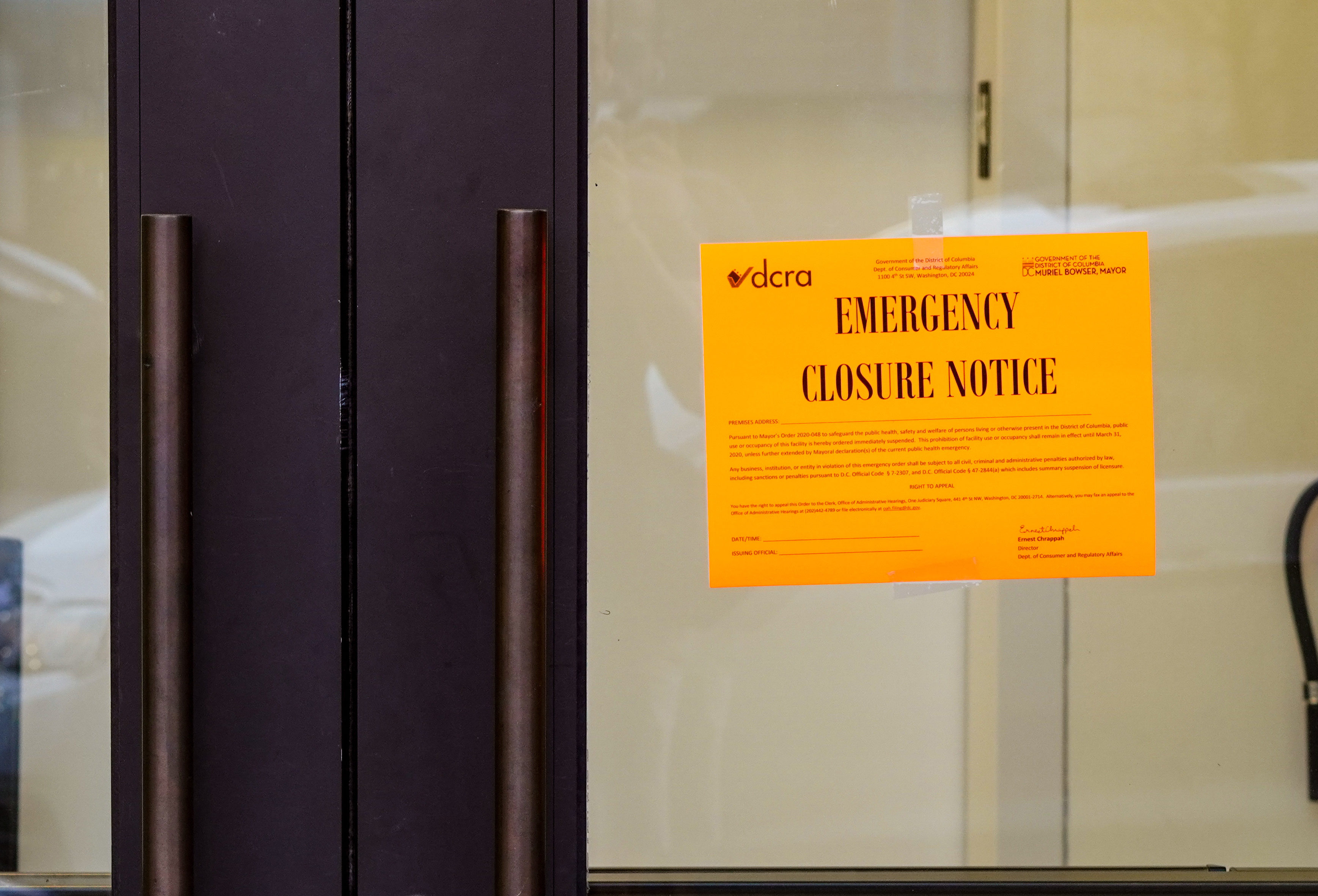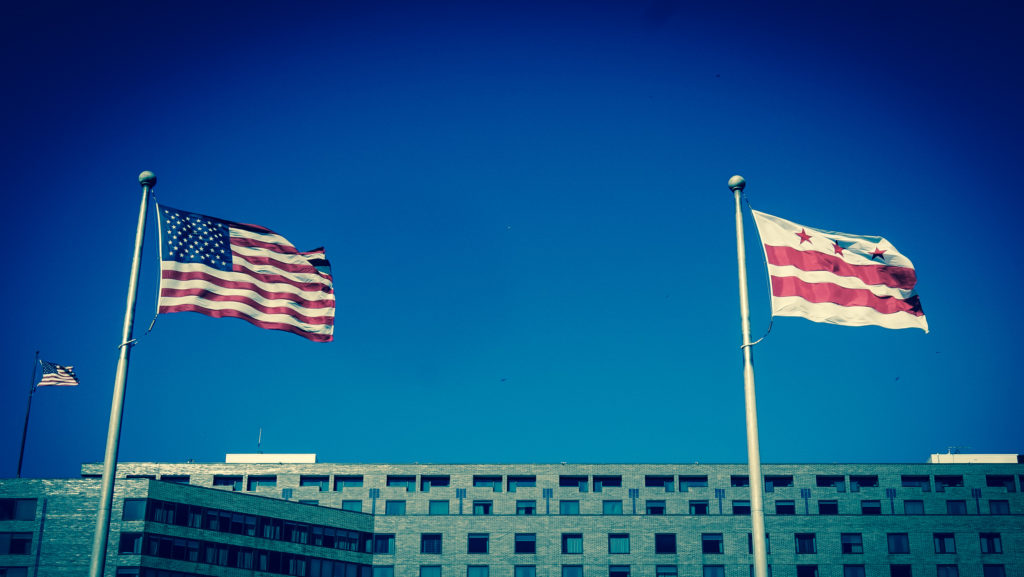This article was originally published on March 24, 2019. It was last updated April 22, 2020.
The outbreak of the new coronavirus disease 2019 (abbreviated COVID-19) has made tens of thousands of people worldwide (and counting) sick, with thousands dead and the crisis deepening daily. Officials have declared the disease a worldwide pandemic. The virus has risen to prominence in the District of Columbia and surrounding region in a few short weeks, taxing healthcare infrastructure and taking a severe toll on the economy. Amid daily and even hourly news during a time with many of the region’s residents social-distancing at home, the D.C. Policy Center has compiled a high-level perspective on the timeline of the local crisis.
Jump to:
- The novel coronavirus emerges
- COVID-19’s arrival in the Washington, D.C. metropolitan region
- Looking ahead: Postponements and deadlines
The novel coronavirus emerges
The new coronavirus emerged in China, at a seafood and poultry market. Within two months, it spread throughout the world causing deaths and severe economic hardship.
Late 2019
- Tuesday, December 31: government officials in Wuhan, China, confirmed that health authorities were treating dozens of cases of pneumonia of unknown cause. It would later be confirmed as COVID-19.
January 2020
- Saturday, January 11: Chinese state media reports the first-known COVID-19 related death. The report came just prior to the country’s widely-celebrated New Year holiday.
- Tuesday, January 21: The first American case of COVID-19 is reported in Snohomish County in Washington State, contracted by a person who had recently returned from the Wuhan region of China.
- Thursday, January 23: Chinese officials lock down the city of Wuhan. Hubei province follows within days.
- Thursday, January 30: The World Health Organization (WHO) declares a public health emergency of international concern, or PHEIC (a designation meant to help support less developed countries and to try to prevent the virus from spreading in those places that are less equipped to detect the disease and handle infections).
- Friday, January 31: The U.S. Department of Health and Human Services (HHS) declares a public health emergency in the United States, a move that gives HHS flexibility in funding and other measures during the coming crisis.
February 2020
- Sunday, February 2: The first COVID-19 death outside China is recorded in the Philippines.
- Friday, February 14: French officials announce a Chinese tourist has died of COVID-19 at a Paris hospital, the first COVID-19 death outside of Asia and the fourth outside mainland China.
- Wednesday, February 19: The Iranian outbreak begins.
- Friday, February 21: The Italian outbreak begins.
- Saturday February 29: The United States records its first coronavirus death and announces high-level travel restrictions and warnings for Italy, Iran, and South Korea.
COVID-19 in the Washington, D.C. metropolitan region
By early March, the virus had arrived in local Washington, D.C. area. Closings, shutdowns, and emergency measures followed rapidly as officials worked to reduce transmission of the virus through social distancing, and prepare the region for the pandemic’s health and economic impacts. Items specific to the District of Columbia are styled in bold.
Saturday, March 7
- The District of Columbia announces its first COVID-19 case, a Reverend at Christ Church Georgetown.
Wednesday, March 11
- WHO declares COVID-19 a global pandemic, the first declared pandemic since H1N1 ‘swine flu’ in 2009.
- Mayor Muriel Bowser declares a public and public health emergency in D.C.
- DC Health recommends the cancellation of mass (1000+) person gatherings.
- President Trump suspends most travel to the U.S from Europe in a prime-time television address.
Friday, March 13
- President Trump declares a U.S. national emergency for COVID-19.
- The District of Columbia bans gathering of 50+, cuts restaurant dining room capacity to half, disallows bar/standing service for social distancing, and closes nightclubs.
Sunday, March 15
- U.S. Centers for Disease Control (CDC) issue guidance recommending U.S. gatherings be limited to no more than 50 people for the next eight weeks
Monday, March 16
- D.C. begins offering free student meals at schools.
- District government begins modified operations with some office closures and allowance for telework.
- Virginia suspends power and water service cutoffs for nonpayment during the pandemic.
- Restaurants, bars, gyms and movie theaters in Maryland are ordered to close.
Tuesday, March 17
- WMATA, the regional transit authority, moves to an essential-travel-only service schedule for both rail and bus service. (Status of local transit service providers)
- D.C. Council passes its first COVID-19 emergency legislation, the COVID-19 Response Emergency Amendment Act of 2020 (B23-0718 or Act 23-247)
- D.C. becomes an eligible jurisdiction for US Small Business Administration COVID-19 disaster loans.
- Virginia Governor Ralph Northam signs an order mandating that businesses limit gatherings to 10 people.
Wednesday, March 18
- Maryland’s state legislature passes COVID-19 response legislation.
Thursday, March 19
- D.C. makes transportation-related adjustments: rush hour parking restrictions are suspended, rush hour reversible lanes on Connecticut Ave & 16th St. are suspended, Circulator fares are suspended to allow all-door boarding and the bus service’s National Mall route is suspended, residential street sweeping is suspended, and booting/towing suspended.
Friday, March 20
- The District of Columbia announces that modified government operations and D.C. Public Schools distance learning is extended to April 27.
Sunday, March 22
- In response to crowds ignoring social distancing during cherry blossom peak bloom, D.C. uses road closures to create ‘restricted access zone’ around the Tidal Basin to mitigate visits to cherry blossoms.
Monday, March 23
- In Virginia, Governor Ralph Northam closes schools for the remainder of the school year.
- Governor Northam announces that all Virginia barber shops, movie theaters, massage parlors, gyms, massage parlors must close. Restaurants and bars must shift to delivery and takeout, in a move that is effective for a minimum of 30 days.
- In Maryland, Governor Larry Hogan shuts down all nonessential businesses.
Tuesday, March 24
- Amid social-distancing concerns, the U.S. Department of Agriculture closes the National Arboretum.
- D.C. schools begin first day of distance learning, following return from early spring break. D.C. also announces the launch of the D.C. Education Equity Fund.
Thursday, March 26
- WMATA will close 19 Metrorail stations and entrances at 9 stations with multiple entries, in a bid to limit employee exposure and save cleaning resources. (map of modified system)
Monday, March 30
- Gov. Larry Hogan issues shelter in place order for the state of Maryland.
- Gov. Ralph Northam issues shelter in place order for the commonwealth of Virginia effective through June 10, 2020.
- Following the lead of Maryland and Virginia, Mayor Muriel Bowser issues a stay at home order for the District of Columbia.
Tuesday, March 31
- Montgomery County, MD passes legislation for a $36M relief package.
Tuesday, April 7
- D.C. Council passes its second COVID-19 response bill, B23-0733 – COVID-19 Response Supplemental Emergency Amendment Act of 2020.
Wednesday, April 8
- Mayor Muriel Bowser issues Mayor’s Order 2020-058 mandating that people wear masks in grocery stores, limiting the number of customers who may be in a store at a given time, and closing self-service stations such as salad bars, among other restrictions.
Friday, April 10
- Mayor Muriel Bowser requests that the National Park Service (NPS) close Beach Drive to vehicular traffic, to assist with social distancing for people exercising on the popular strip.
Wednesday, April 15
- Mayor Muriel Bowser extends D.C.’s public health emergency to May 15, including school closure, ban on gatherings of 10 or more people, restaurant/public gathering restrictions, limited DC government operations, etc.
Tuesday, April 21
- D.C. Council tweaks its recent COVID-19 response bills, with changes that include a further extension for the mayor’s budget submission and the expansion of a rent-hike prohibition to cover commercial tenants.
Friday, April 24
- Pandemic Unemployment Assistance for independent contractors, gig workers, 1099s, new hires and those who have exhausted unemployment insurance becomes available in the District of Columbia via dcnetworks.org.
Looking ahead: Postponements and deadlines
Tuesday, May 12
- Likely postponement date for D.C.’s budget submission and adoption processes.
Friday, May 15
- Current end date to D.C. public health emergency, including:
- Large-group bans
- Restaurant restrictions
- Limited D.C. government operations
Friday, May 29
- Final day of school year for DCPS and public charter schools.
Tuesday, June 30
- D.C. hotel property and sales tax due (deferred).
Wednesday, July 15
- Federal and D.C. personal income tax filings and payments due (deferred).
Monday, July 20
- D.C. retail sales tax due (deferred).
If you have corrections or additions to offer, please email the author at aimee@dcpolicycenter.org.


